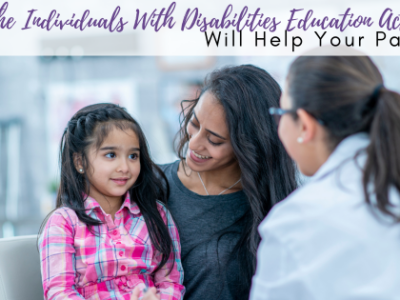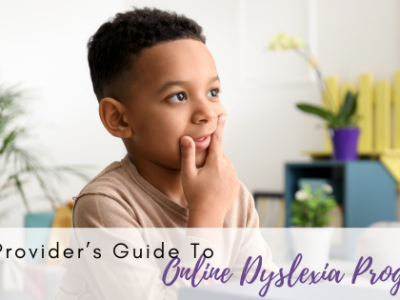
What To Do When Your Patients Need Dyslexia Treatment
Primary care providers can be such an important part of patients’ and families’ lives. Whether parents or patients share concerns or ask questions about topics like mental health, relationships, or even experiences at school, practitioners can help to discuss different solutions. The same is true when it comes to patients who have learning disabilities. Perhaps a parent points out difficulties with reading, or maybe a patient hints at struggles in the classroom; in any case, a doctor can work with patients and families to offer guidance and figure out some next steps. One key thing to keep in mind is that it’s important to direct patients with dyslexia to qualified professionals for the right kind of evaluation and treatment. Read on to learn more about what to do when your patients need dyslexia treatment.
Recommend a professional evaluation. When it’s suspected that a patient is dealing with a learning disability, a visit with a specialist is key. This can help to identify the specific challenges, strengths, and weaknesses of a patient. In addition, working with an experienced specialist can lead to a more definitive diagnosis and a personalized treatment plan for the patient.
Encourage your patients and their parents. Dealing with dyslexia can be daunting. It is a good idea to emphasize the potential for success that comes with the right dyslexia treatment. For patients, help them to understand that a dyslexia diagnosis can be a positive thing; it can help to point a patient in the right direction to get the support and intervention they need in order to develop stronger reading and writing skills. Providers may want to also encourage open communication between parents and teachers so that support strategies remain consistent at both home and school. Part of this communication process includes advocacy for a child’s needs in the classroom when it comes to accommodations and access.
Point patients to potential treatment options. While a specialist can help to determine the most suitable approaches for a patient who has dyslexia, it is essential that dyslexia programs have certain components including:
- Multisensory instruction: For learners with dyslexia, multisensory instruction can be so effective. This kind of approach involves visual, auditory, and kinesthetic methods that help to reinforce letter-sound connections. Altogether, this can help to improve reading fluency.
- Orton-Gillingham based programs: Orton-Gillingham is a structured literacy approach, and it has stood as the gold standard of dyslexia instruction for decades. These programs target specific phonics skills such as decoding, reading fluency, and spelling.
- Highly qualified instructors: Certified Academic Language Therapists are the gold standard when it comes to dyslexia therapy
Let families know about available resources. It is so important for families to know that they’re not alone in their journey to helping students with dyslexia. Whether you’re gathering more information about dyslexia or seeking a solution for actual treatment, some helpful websites to share include:
- Dyslexia on Demand, a great option for helping students with dyslexia, offers a page that links to these resources.
- The National Center on Improving Literacy (NCIL) offers support for parents and has plenty of factual information on dyslexia.
- The National Center on Intensive Intervention can be a great resource for educators and parents; it explains so much about data-based instruction and intervention for dyslexia. This site can help families to understand more about the quality of what is being implemented in schools.
- Wrights Law is a web site that covers the rights of parents and students under the Individuals with Disabilities Education Act (IDEA), Section 504, as well as relevant court rulings that deal with the rights of students.
- The Academic Language Therapy Association (ALTA) is an international organization that credentials the dyslexia professionals known as Certified Academic Language Therapists.
- The International Dyslexia Association has a huge digital library that serves as a free resource for patients with dyslexia and their families.
The right interventions are crucial to success. This is such a key point to drive home to patients and their families. Dyslexia on Demand offers convenient, tailored, and trusted help for students with dyslexia. See what Dyslexia on Demand has to offer:
- Certified Academic Language Therapists: Also known as CALTs, these experts work to review comprehensive evaluation reports, academic samples, and academic skills assessments in order to get a baseline documentation of each student’s performance. This helps to inform diagnostic and prescriptive intervention for subsequent dyslexia treatment.
- A multisensory approach: CALTs integrate visual, auditory, and motor processing with an explicit understanding of the structure of the English language. This helps to provide students with a solid foundation in written language skills.
- Intensive instruction: At Dyslexia on Demand, CALTs offer skilled, one-on-one or small group interventions. These occur with high frequency over a sustained period of time.
- Orton-Gillingham programs: The Take Flight therapy program that is used at Dyslexia on Demand includes the essential components of the Orton-Gillingham approach. From vocabulary and phonemic awareness to fluency and reading comprehension, this therapy program can truly help students to improve and sustain reading and writing skills.
At Dyslexia on Demand, we believe that every child ought to have the opportunity to become academically successful—no matter what learning disability or challenge they face. Refer your patients to experts with more than 500 years of combined dyslexia experience. Find us at DyslexiaonDemand.com, or give us a call at 512-387-6365.







